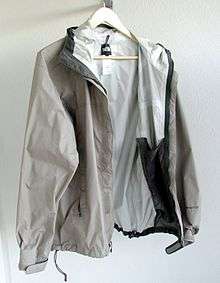Layered clothing
Layered clothing is a term describing a way of dressing using many garments that are worn on top of each other. Some of the layers have different, largely non-overlapping, functions. Using more or fewer layers, or replacing one layer but not others, allows for flexible clothing to match the needs of each situation. Two thin layers can be warmer yet lighter than one thick layer, because the air trapped between layers serves as thermal insulation. Layered clothing is particularly relevant in cold climates, where clothing must at the same time transfer moisture, provide warmth, and protect from wind and rain. In a hot and dry climate, clothes have very different functional requirements: they must block the radiation from the sun, and allow for sufficient air circulation. Therefore, layered clothing in the sense used in this article is largely irrelevant in hot and dry climates. The wicking layer moves the sweat from your skin, where it can be absorbed by the other layers.
Outdoor and sports wear manufacturers favor layered clothing because, among other reasons, it allows them to offer so-called "technical" or "functional" clothes which are optimized for the particular demands of a specific sport or activity. Such clothes are often made of advanced synthetic materials or wool, and is not very expensive
Layers
Usually at least three layers are identified as follows:
- Inner layer provides comfort by keeping the skin dry. Also called base layer or first layer.
- Mid layer provides warmth. Also called insulating layer.
- Shell layer protects from wind and/or water. Also called outer layer which works as protection over the other two layers.
Often clothes combine two adjacent layers, as in the case of warm undergarments that provide both comfort and insulation.
Inner or base layer
The purpose of the inner layer is to draw the sweat away from the skin to the next layers, which makes the wearer feel warmer and more comfortable. The transfer of moisture happens due to capillary action, sometimes called wicking. The used materials are called wicking materials. When moisture has moved from the skin into (nonabsorbent) clothing, it has more surface area and will evaporate faster. If a piece of clothing does not transfer moisture well, it is not strictly an inner layer garment at all, but simply a comfortable mid-layer garment.
- Wool has a combination of wicking and water-repelling properties[1] and, along with silk, is the most expensive of the materials used for base layers. How comfortable wool feels against skin varies greatly, with Merino wool being softer . Wool is highly odor resistant.[2]
- Synthetic materials such as polyester, polyethylene, and microfiber-based fabrics are inexpensive. They have excellent water wicking properties. They can also carry specialist finishes, such as anti-bacterial agents which reduce odors, and insect repellent. However, in the absence of such anti-odour treatment they quickly become notoriously foul-smelling. This is because their hydrophobicity causes them to strongly absorb the short-chain fatty acids that are responsible for body odor.
- Silk is expensive. It feels comfortable, but is less warm, weaker and harder to take care of.
- Cotton is usually inexpensive. It absorbs moisture easily and is slow to dry out. When wet or damp, cotton loses its insulative abilities and becomes more thermally conductive than other materials. This makes it suitable for warm temperatures but potentially dangerous for cold and/or wet conditions. You will commonly hear that cotton is better forgotten because it is so cold when wet.
Mid layer
The mid layer is needed in cold weather to provide additional insulation. The use of multiple thin layers facilitates adjustment of warmth. The mid layer should be more loose-fitting than the inner layer, as this leaves insulating air between the layers. However, if best possible moisture transfer is desired, too great a gap between any adjacent layers of clothing may reduce the moisture transfer by capillary action from one piece of clothing to another. On the other hand, very loose-fitting layers can allow more removal of moisture (and heat) via air circulation.
- Wool is the traditional mid layer material with several good properties: it has good insulation even when wet, absorbs moisture but does not feel wet even when it holds significant moisture, and transfers moisture.
- Fleece made from PETE or other synthetics has many of the features of wool, but is lighter. It provides good insulation even when wet, absorbs very little moisture, and dries quickly. Although no longer commonly used in the industrialized world, natural sheepskin fleece could also serve the mid layer function.
- Down has a very good warmth:weight ratio, and can be packed down (squeezed) to take very little room. On the downside, it is expensive, makes a thick garment, dries slowly, loses its insulating properties when wet or compressed, and stops lofting properly after being washed several times.
- Synthetic Fiberfill such as polyester fiber is used similarly to down, but does not have as good a warmth:weight ratio. However, it is less expensive, provides better insulation when wet, dries quickly, and absorbs very little moisture. There are brands of very fine fiberfill like Thinsulate, PrimaLoft or Thermolite, that provides higher warmth for a given thickness.
- Cotton, as with the inner layer, is a cheap alternative, but a reasonable choice only when low insulation and moisture transfer is needed. Most people involved in outdoor activities would agree that cotton is a very poor material to wear in the outdoors because you MAY need to insulate yourself and, unless you are not moving, you WILL need moisture transfer.
Shell layer

The outermost clothes are called the shell layer, but only if they block wind or water, or have good mechanical strength. Ideally the shell layer lets moisture through to the outside (that is, is breathable), while not letting wind and water pass through from the outside to the inside. While this is enabled to some degree by modern materials, even the best and most expensive materials involve a slight trade-off between breathability and water- and wind resistance.
If heavy sweating is expected, one should avoid wearing any shell layer garments unless their protective properties are essential. For example, when one is jogging, no traditional shell layer is likely to be able to transfer enough moisture to keep the wearer feeling dry. But as more air permeable membranes emerge, when combined with pit zips the amount of moisture being transferred outwards would be sufficient for cardiovascular pursuits. As a general rule, one should consider using sufficiently warm mid layer clothes.
Both "soft" and "hard" shell jackets and layers exist. Hard shells are commonly woven fabric and do not rip. Soft shell may rip easier, but are more flexible.
- Plastic raincoats protect completely from water and wind, but let through no moisture. To compensate for that, such raincoats usually have flap-covered holes and are very loose-fitting at the bottom to allow air circulation.
- Waterproof breathable (hard shell) materials are waterproof and somewhat breathable. Their essential element is a thin, porous membrane that blocks liquid water, but lets through water vapor (evaporated sweat). The more expensive materials are typically more breathable. The best-known brand is Gore-Tex, while one study shows that eVent, a newer material, has the best breathability, although it has less wind resistance.
- Water resistant (soft shell) materials generally block water only partially, however as technology in the outdoor industry moves forward more fully waterproof soft shells are emerging such as polartec neoshell or DryQ Elite. On the other hand, they are usually more breathable and comfortable, thinner, and cheaper than completely waterproof materials. Water-repellent coatings are often used. Before waterproof-breathable shells were invented, the "60/40" (60% cotton, 40% nylon) parka was widely used. Soft shells are not water "proof".
- The term soft shell is increasingly used to describe garments that combine partial or full water resistance with partial or full wind breaking ability. Soft shell fabrics come in numerous varieties with many garments offering a combination, such as a wicking layer. In many cases insulation is combined in an attempt to replace several layers with a single highly flexible one. One of the most unique characteristics of the woven softshell fabrics is the combination of windproofness, a high level of water resistance, and stretch -- in many cases four-way stretch. Solid plastic films and micro-perforated laminates typically breathe much less and do not stretch at all.
Adjusting a layering system
As the intensity of exercise or environmental conditions change, the amount or quality of layers worn should be changed. In particular, if clothes become wet from sweating during heavy exercise, they can be much too cold during the following period of rest. Below are two basic strategies for this problem.
Vents
Some clothes feature adjustable vents, such as below armpits. The positioning and design of the vents allow for area specific cooling while only marginally reducing exterior moisture resistance.
Removing layers
Removing the shell layer during heavy exercise can pose problems if the clothes underneath lack required mechanical strength or waterproofing. In such situations, using a mid layer with enough of the required shell layer properties can be a good choice.
Fashion use

Combining different garments in layers can be used to create a variety of outfits. This provides similar practical benefits for practical layering, in that the wearer can shed layers according to changes in temperature, and is also a way of making use of clothing to produce different looks and mix colors in various ways.[3] It saves money for the consumer, who can create a totally new look simply by swapping out one piece of the outfit.
References
- "What Makes Wool So Special?". The wool revolution. Archived from the original on 2016-04-07. Retrieved 11 April 2016.
- "Best Merino Wool Base Layers". gearjunkie.com. 31 January 2006.
- "How To Layer Clothing and Look Fashionable". Tasty Pretty Things. Archived from the original on 2010-09-25.